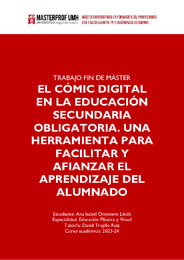Por favor, use este identificador para citar o enlazar este ítem:
https://hdl.handle.net/11000/33242Registro completo de metadatos
| Campo DC | Valor | Lengua/Idioma |
|---|---|---|
| dc.contributor.advisor | Trujillo, David | - |
| dc.contributor.author | Ontenient Lledó, Ana Isabel | - |
| dc.contributor.other | Departamentos de la UMH::Arte | es_ES |
| dc.date.accessioned | 2024-09-20T07:45:53Z | - |
| dc.date.available | 2024-09-20T07:45:53Z | - |
| dc.date.created | 2024 | - |
| dc.identifier.uri | https://hdl.handle.net/11000/33242 | - |
| dc.description | Especialidad: Educación Plástica y Visual | es_ES |
| dc.description.abstract | Hoy en día existen múltiples aplicaciones digitales que permiten generar historietas, lo cual resulta muy útil en las aulas de Educación Secundaria Obligatoria. Su uso enriquece el contenido curricular de las distintas materias al mostrarlo con imágenes contextualizadas y un lenguaje más sencillo que lo hacen más fácil de entender. El presente Trabajo de Fin de Máster se centrará en los cómics en formato digital por sus ventajas a la hora de confeccionar historietas interactivas. Se busca cumplir un objetivo principal que implica realizar un estudio en el que se destaca el cómic digital como una herramienta que facilita el aprendizaje del alumnado, a través de una revisión bibliográfica. Los resultados indican que el cómic digital empieza a utilizarse con frecuencia como herramienta educativa en la Educación Secundaria Obligatoria en los últimos años, y se han puesto en marcha iniciativas para promover esta estrategia educativa, como cursos de formación para el profesorado y el uso de las redes sociales para difundir el cómic educativo entre los jóvenes. Entre las ventajas del cómic virtual frente al tradicional, se observa que el primero posee un factor de interactividad, el cual permite al alumno visualizar animaciones o sonidos incluidos en el cómic, hacer aparecer y desaparecer elementos, decidir el final de la historieta, etc. Estas cualidades convierten al tebeo digital en un soporte educativo más atractivo que, por otro lado, simplifica el aprendizaje al explicar el contenido de forma más amena y con imágenes que lo ilustran. | es_ES |
| dc.description.abstract | Nowadays there are many digital applications that allow the generation of comic strips, which is very useful in obligatory secondary education classrooms. Their use enriches the curricular content of the different subjects by showing it with contextualised images and a simpler language that makes it easier to understand. This Master's thesis will focus on comics in digital format because of their advantages when it comes to creating interactive comics. The main objective is to carry out a study in which digital comics are highlighted as a tool that facilitates student learning, through a bibliographic review. The results indicate that digital comics have begun to be used frequently as an educational tool in Compulsory Secondary Education in recent years, and initiatives have been launched to promote this educational strategy, such as training courses for teachers and the use of social networks to disseminate educational comics among young people. Among the advantages of the virtual comic over the traditional one, it is noted that the former has an interactivity factor, which allows the pupil to visualise animations or sounds included in the comic, make elements appear and disappear, decide the end of the comic, etc. These qualities make the digital comic a more attractive educational medium which, on the other hand, simplifies learning by explaining the content in a more pleasant way and with images that illustrate it. | es_ES |
| dc.format | application/pdf | es_ES |
| dc.format.extent | 34 | es_ES |
| dc.language.iso | spa | es_ES |
| dc.publisher | Universidad Miguel Hernández de Elche | es_ES |
| dc.rights | info:eu-repo/semantics/openAccess | es_ES |
| dc.rights.uri | http://creativecommons.org/licenses/by-nc-nd/4.0/ | * |
| dc.subject | Cómic | es_ES |
| dc.subject | Nuevas tecnologías | es_ES |
| dc.subject | Interactividad | es_ES |
| dc.subject | Historieta | es_ES |
| dc.subject | Digital | es_ES |
| dc.subject.other | CDU::3 - Ciencias sociales::37 - Educación. Enseñanza. Formación. Tiempo libre | es_ES |
| dc.title | El cómic digital en la educación secundaria obligatoria. Una herramienta para facilitar y afianzar el aprendizaje del alumnado | es_ES |
| dc.type | info:eu-repo/semantics/masterThesis | es_ES |

Ver/Abrir:
ONTENIENT LLEDO, ANA ISABEL_1821446_assignsubmission_file_OntenientLledó_AnaIsabel_74440354A_compressed.pdf
557,16 kB
Adobe PDF
Compartir:
 La licencia se describe como: Atribución-NonComercial-NoDerivada 4.0 Internacional.
La licencia se describe como: Atribución-NonComercial-NoDerivada 4.0 Internacional.
.png)